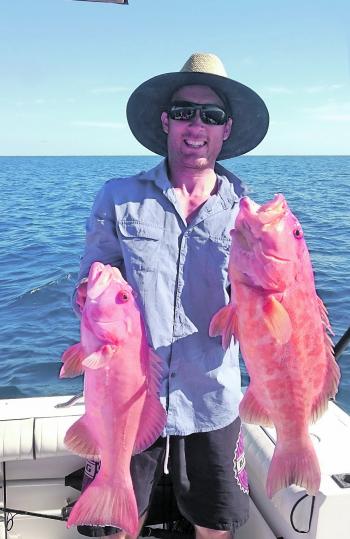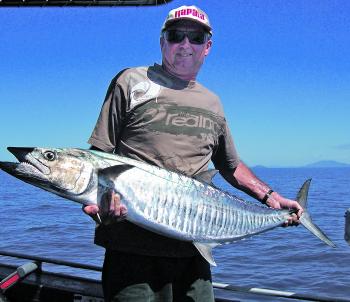Winter in the north usually follows one of two patterns. Either we get lots of calm periods with short blows in between, or we get lots of blows with short periods of calm weather in between.
This winter is shaping as the latter, with a continual march of high pressure systems across the Great Australian Bight. The high then ridges up the north Queensland coast, creating extended periods of heavy winds, with only small windows of opportunity between the highs. The key to successful fishing in these conditions is to watch the patterns and grab any opportunity when the wind drops below about 15 knots for small boats and 20 knots for big boats. The positive is that these systems are pretty predictable, and you can plan in advance to take advantage of the drop in winds, however few and far between.
July typically has the lowest average water temperature for the year in Cairns, and this is currently on track to occur this year. This should bring the mackerel closer to the surface, making them easier to target for anglers. They can still be caught when they sit deeper, but it does take a bit more effort and ingenuity on the part of anglers. Spaniards tend to rise early and late in the day, making these the ideal times to troll swimming gar, mullet, wolf herring, live baits and lures. In the middle of the day, even in the coldest conditions, go deep using super deep diving minnows, down riggers or paravanes.
Paravanes are a method that seems to have declined in popularity over recent decades, probably due to most anglers now targeting mackerel using rod and reel. They are a very effective way to fish for mackerel down deep and won’t sting the pocket as badly as a downrigger. They can still be used quite effectively on a rod, as long as you keep the distance between the paravane and the lure or bait under 2m and you carry a long handle gaff in the boat.
Fight the fish until the paravane is at the rod tip and move forward in the boat so your gaffer can nail the Spaniard at the back of the boat. Keep the boat moving forward slowly, under power, rather than putting the motor into neutral. This keeps constant pressure on the fish, making it less likely to throw the hooks and easier to bring alongside the boat for gaffing.
Cobia and trevally of all shapes and sizes will also be on the chew, so make sure your gear is well serviced and up to the task of grinding it out with a serious cobia, or the blistering speed of a monster trevally or spaniard.
The lesser mackerel will be around inshore, with July usually considered the real start of the season. Take any small drop in the winds as a chance to venture out on dawn to the more protected inshore islands, reefs, wrecks and pinnacles. Trinty Inlet has some good options, as you can poke out as far as the winds will allow, hopefully getting right out to the end of the leads. If not, just look for bait on your sounder in closer and focus your efforts in that area. Mackerel will push right up into the inlet itself, at times, so you are always in with a chance of nailing a mackerel even in pretty strong winds.
Reef fishing has been productive for some when small boat anglers have been able to get out there. Others have struggled to find a feed, so it is still a bit hit and miss. The cooler weather will see the fish school up more, so it should be just a matter of being able to get at them. Trout will be moving up shallow and more nannygai and red emperor will be found in shallower water.
Sharks continue to be a nightmare for most, though one angler has had success in avoiding them. Beau Lockhard has been stopping fishing for half an hour or so after they show up. He got everyone on his boat to wind in once the sharks arrived, had a cuppa and a feed, and found they had moved on when they dropped back down. He said it took a while for the fish to get seriously back on the bite after the break, but the sharks had gone. It has to be worth a shot, as I haven’t heard of anything else working, other than relocating.
The estuaries have continued to produce the odd barra, golden snapper and mangrove jack, but they have slowed with the water temperature. Reserve those warm, still, sunny days for targeting these fish and you will still have success if you put in the effort.
On those windy, overcast, winter days, switch to light tackle and target bream, whiting, flathead and grunter and you will still be able to rustle up a feed. We tend to get a bit spoilt in the north and ignore these good table fish in preference to bigger and more spectacular tropical species. They are great fun and are an especially attractive option for kids. There is plenty of action to keep them occupied before having their rod nearly pulled from their hands by a more powerful fish. As they gain experience and confidence, by all means move them onto harder-fighting fish, but don’t put them off by going too big too soon. Kids will have just as much fun pumping yabbies or helping get fish and prawns out of a cast net as they will fishing itself, so include bait gathering in the outing for more kid friendly fun.
Reads: 2733
Beau Lockhard managed to get these trophy trout past the sharks.

There will be plenty more Spaniards taken this month, like this beauty caught aboard Blackout Sportsfishing Charters, as July is considered the real start of the mackerel season.




